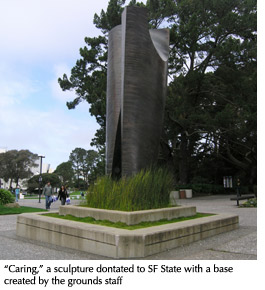| |
|||||
|
SF State campus grounded in excellence | ||||
|
November 15, 2006 |
|||||
 SF
State garnered a national 2006 Green Star Award for best maintained grounds
of an urban university. Awarded by the Professional Grounds Management
Society (PGMS), an organization of park, playing field and campus grounds
managers, the award recognizes aesthetic and technical skill. Director
of Campus Grounds Phil Evans accepted the award on behalf of SF State
at the annual PGMS meeting held Nov. 4 in Columbus, Ohio. SF
State garnered a national 2006 Green Star Award for best maintained grounds
of an urban university. Awarded by the Professional Grounds Management
Society (PGMS), an organization of park, playing field and campus grounds
managers, the award recognizes aesthetic and technical skill. Director
of Campus Grounds Phil Evans accepted the award on behalf of SF State
at the annual PGMS meeting held Nov. 4 in Columbus, Ohio.
"The campus grounds are the first and last impression of the University for all visitors," Evans said. "We strive to maintain the quality of a personal garden, giving each visitor a sense of ownership." At 134 acres, the SF State campus is home to sports fields, expanses of lawn used for social gatherings, a variety of gardens and an urban forest of about 1,200 trees. The responsibilities of the grounds staff are as much about safety as they are about keeping up the campus' award-winning appearance. Two arborists monitor and maintain about 500 of the trees that occupy high traffic areas and require regular inspection for weak or broken limbs, insect damage, diseases, aging and other causes of deterioration and weakness. In addition to the plant life, the staff maintains the "hardscape," walkways, paved plazas and roads between buildings and the parking garages. The removal of gum, food spills, litter and other debris are a crucial part of the department's daily work, which begins at 4 a.m. Due to the frequency of sports played and events staged on campus, Cox Stadium, Maloney Field and the central campus quad lawns demand rigorous upkeep every day. The department relies on students from a variety of disciplines to assist staff with planning and planting the grounds. Industrial design and engineering students and faculty have devised ways to improve the user-friendliness of the campus including a web of solar-powered audible landmarks to help improve navigation throughout the campus, and the development of outdoor seating and tables. A book, "Accessible Landscapes, Designing for Inclusion," written by Evans and design and industry faculty, is used nationally as a reference textbook for landscape design. Also responsible for the installation, construction and maintenance of fences and outdoor lighting, the department often finds creative -- even artistic -- solutions to routine problems. A chain-link gate in front of an emergency generator was replaced with a rustproof steel sculpture door designed by a student artist and designer. When "Caring," the vertical sculpture between the administration building and campus quad, was donated to SF State it arrived without a base. Grounds staff built a square concrete base surrounding the sculpture that also serves as a popular sitting area and contains two shallow, tiered garden boxes. The baumea, a solid stem, grass-like plant in the upper box, mirrors the upward movement of the sculpture, which was created by Aristide Demetrios, a former San Francisco art commissioner. Accepting the award, Evans told his colleagues that "the 25 employees in the SF State Grounds Department work with remarkable personal and professional care. And they have adopted exceptional quality as their daily standard." A photo tour of campus grounds is available on the Facilities and Service Enterprises Web site.
|
|||||
 |
1600 Holloway Avenue, San Francisco, CA 94132 (415) 338-1111 |